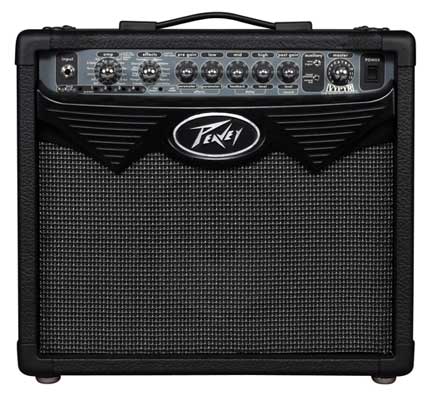Peavey Vypyr 15 Review(Ericseiv | Posted 2009-12-08)  After firmly planting its feet in the tube amp market with the 5150/6505, XXX, JSX and Classic series amps and producing impressive solid-state technology with the Transtube amp line, Peavey is now throwing its hat into the digital modeling amp ring with the new Vypyr series of guitar amps. The Vypyr series ranges from small bedroom-sized 15 watt 1x8 practice amps (reviewed here) to larger, gig-approved 120-watt tube-powered 2x12 combos. All Vypyr amps model the standard classic amps such as a Mesa/Boogie Dual Rectifier, Marshall Plexi, Fender Twin, Vox AC30 and Marshall JCM800. The amp also models Peavey amps like the 6505, JSX, XXX and Classic. It also models Krank and Diezel amps. The amp also features effects such as reverb, delay, a Tubescreamer simulation, chorus, phase, flanger and tremolo among others. All effects and amp models can be accessed by rotating the front panel knobs and pressing the "edit" button to dial in your tone. The controls are very easy to identify and the amp is user-friendly. I was up and running within minutes without even having to look at the manual. Being easy to use is a plus for the Vypyr-the instruction manual does not come as a pamphlet but is included on a cd rom, so waiting for your computer to boot up so you can read the manual could mean losing your inspiration to practice. So what sets the Vypyr apart from other modeling amps like Line 6 and Vox Valvetronix? Instead of simply modelling a single tone from a guitar amp, the Vypyr models both channels-clean and distortion-of a selected amp. Dial in a hot-rodded Marshall tone from the JSX model and the channel selector glows red. Press the Amp Model knob and the amp simulates the clean channel of the JSX, and the channel indicator turns green. This means that the user has 24 amp models to choose from. Add in the capability to have four programmable channels and three effects used simultaneously, and there's no excuse to not find usable tones with this amp. Of course, all those features don't mean squat if the amp simulations aren't believable, and the Vypyr delivers in the tone department. The 6505 model features the mid-range heavy "brown sound" that made Eddie Van Halen choose Peavey amps for most the '90s. The Marshall Plexi is a clean sound with a touch of British growl. Add the Tubescreamer simulation to the Plexi model and it turns into classic metal just the way Randy Rhoads, Georgy Lynch and James Hetfield did it back in the good old days. The Dual Rectifier setting is mid-scooped and compressed...perfect for nu-metal. Switch to one of the clean Fender models and add some chorus and you'll have clean tones made famous by David Gilmour. In fact, the tones are so good I had a tough time finding a tone I could stick with..I kept finding tones that I liked. One day I wanted to use the JSX model as my "signature" practice tone, the next day I wanted to use a Marshall tone, the next day I wanted to use a XXX tone. To my ears, the Vypyr did not sound as digital or synthetic as other modeling amps-the Vypyr's gain tones are thick and crunchy and not at all buzzy or thin. I practiced for hours without any ear fatigue, which is a common occurence with me when playing digital amps. Even though I'm heavily impressed with the Vypyr 15, there are a few areas where I'll deduct points. The amp is not compatible with the Sanpera footswitch, which means the user can't truly take advantage of all the amp's features. Also, upon initial power up, the amp goes into a default mode, which means you have to twist some knobs and press some buttons to find your favorite tone. If you can't remember how you had your favorite tone dialed in during a previous jam session, you're out of luck. But that's nitpicking for an amp that is made for bedroom practice. Did I mention the price? I paid $89 for mine at Guitar Center-not bad considering I now have access to Marshall, Fender, Diezel and Mesa amp tones in my bedroom. With the Vypyr series, Peavey only adds to its impressive array of affordable amps.
|
|

